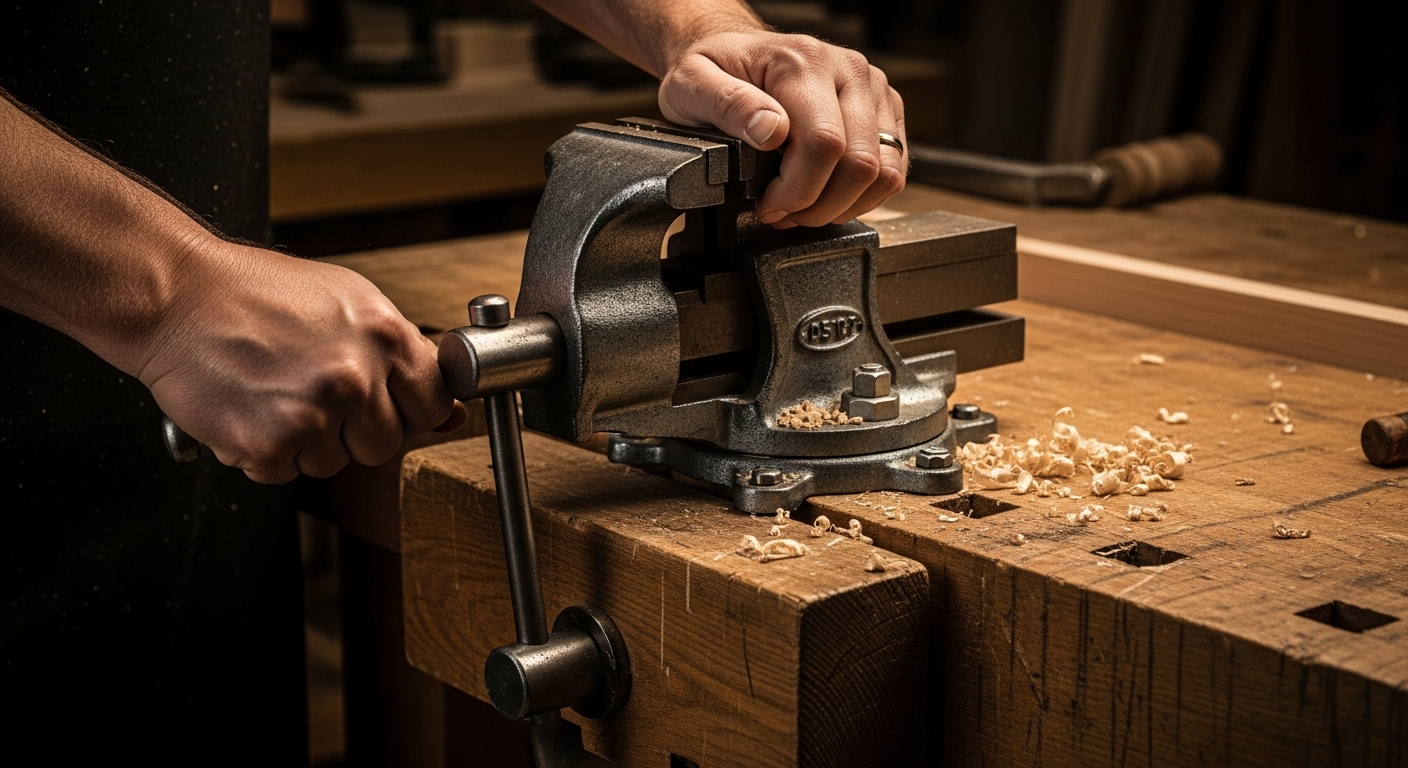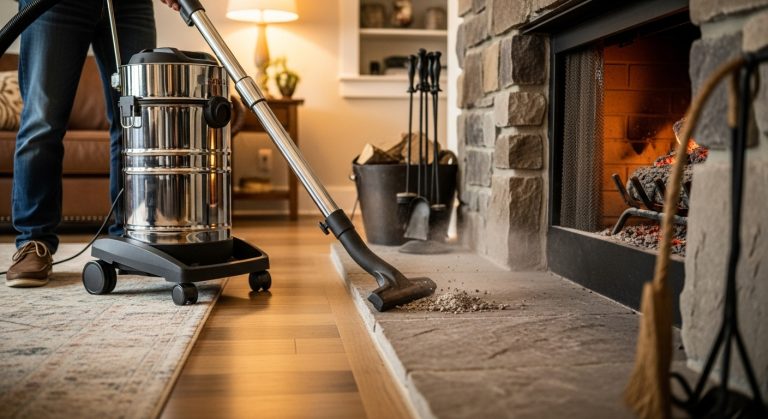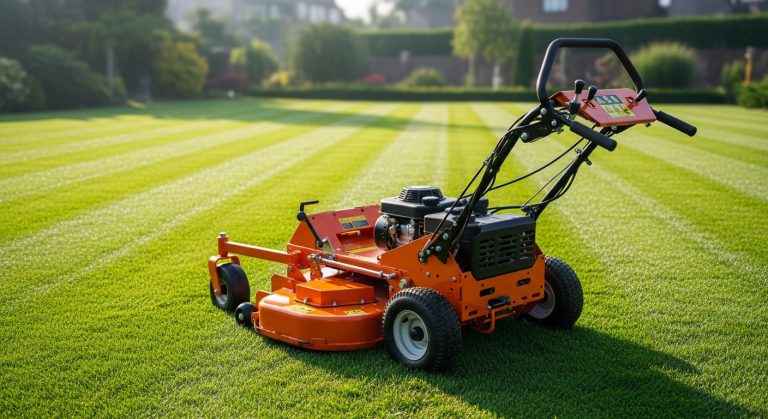Best Woodworking Vise: Ultimate Guide for Precision Work
Every serious woodworker knows that precision starts with the right vise. Whether you’re crafting fine furniture or tackling weekend projects, your vise becomes the foundation of quality work.
The best woodworking vises combine superior clamping force, smooth operation, and durable construction to transform your workshop into a precision workspace.
This comprehensive guide reveals everything you need to select the perfect vise that will elevate your craftsmanship and make every project more enjoyable. Discover the features that matter most and find your ideal workshop companion.
Key Takeaways
- Quick-Release Mechanisms Dramatically Improve Workflow Efficiency: Quick-release levers transform how you work by allowing rapid jaw positioning without turning the main screw through its full range. This feature saves significant time during frequent workpiece changes and reduces fatigue during extended work sessions. Professional woodworkers consistently praise this mechanism for boosting productivity in busy workshops.
- Cast Iron Construction Provides Superior Durability and Stability: Heavy-duty cast iron bodies offer the mass and rigidity that serious woodworking demands. This material dampens vibrations, maintains accuracy under load, and provides decades of reliable service. While heavier than alternatives, cast iron construction ensures your vise remains a long-term workshop investment.
- Jaw Capacity Must Match Your Project Requirements: Proper jaw opening capacity determines the range of projects you can tackle effectively. Most quality vises offer 7-10 inch jaw openings, accommodating standard lumber dimensions. Consider your largest common workpieces and add 20-30% extra capacity for future projects and unexpected needs.
- Dual Guide Rod Systems Ensure Parallel Jaw Alignment: Two guide rods maintain perfect jaw alignment during operation, ensuring even pressure distribution across workpiece surfaces. This parallel action prevents workpiece damage and provides consistent clamping force. Single-rod systems lack this precision and should be avoided for serious woodworking applications.
- Throat Depth Affects Workpiece Accommodation Flexibility: Deeper throat depths accommodate wider panels and provide more positioning options on your workbench. Most quality vises feature 3-4 inch throat depths, suitable for standard woodworking tasks. Consider your bench design and typical project dimensions when evaluating throat depth requirements.
- Proper Installation Requires Adequate Bench Support: Structural bench preparation ensures optimal vise performance and prevents damage during heavy use. Your workbench must provide adequate support for the substantial forces generated during clamping operations. Reinforce mounting areas if necessary and follow manufacturer specifications for bolt sizes and torque requirements.
- Regular Maintenance Preserves Smooth Operation and Longevity: Consistent cleaning and lubrication maintain smooth operation and prevent premature wear of critical components. Remove sawdust and debris regularly, especially from screw threads and guide surfaces. Use manufacturer-recommended lubricants and work mechanisms through their full range to distribute lubrication evenly.
Woodworking Vise Fundamentals
A woodworking vise serves as the cornerstone of any well-equipped workshop. These essential tools secure workpieces firmly in place, allowing craftsmen to perform detailed operations with confidence and precision. The right vise transforms challenging tasks into manageable ones.
What Makes a Quality Woodworking Vise?
Superior construction materials form the backbone of exceptional vises. Cast iron bodies provide unmatched stability and longevity. Steel screws and guides ensure smooth operation even under heavy loads. Quality hardware resists wear and maintains accuracy over years of use.
Clamping capacity determines the range of projects you can tackle. Most quality vises offer jaw openings between 7 to 13 inches. Deeper throat depths accommodate larger workpieces. Consider your typical project sizes when evaluating capacity requirements.
Smooth operation separates premium vises from basic models. Well-engineered mechanisms operate effortlessly with minimal backlash. Quality bearings and precise machining create the smooth action that professional woodworkers demand.
Essential Vise Components
The main screw drives the clamping action and bears the primary load. Acme threads provide optimal balance between speed and holding power. Steel construction ensures durability under repeated stress cycles.
Guide rods maintain jaw alignment during operation. Dual guide systems offer superior stability compared to single-rod designs. Hardened steel guides resist wear and maintain precision over time.
Jaw faces contact your workpieces directly. Replaceable wooden faces protect delicate surfaces. Some vises feature quick-change jaw systems for different materials and applications.
Types of Woodworking Vises
Front Vises
Front vises mount to the front edge of workbenches and excel at holding boards for edge work. These versatile tools handle most general woodworking tasks with ease. Their accessible position makes them ideal for frequent use.
The quick-release mechanism on many front vises speeds up workpiece changes. A simple lever disengages the screw for rapid positioning. This feature dramatically improves workflow efficiency during complex projects.
Jaw capacity typically ranges from 7 to 10 inches on quality front vises. This range accommodates most common lumber dimensions. The parallel jaw action ensures even pressure distribution across workpiece surfaces.
Tail Vises
Tail vises integrate into the end of workbenches and work with bench dogs for comprehensive workholding. These systems excel at securing long boards and panels for surface operations like planing and sanding.
The dog hole system creates infinite positioning options along the bench length. Square or round dogs fit into corresponding holes. This flexibility handles workpieces of virtually any length with proper support.
Heavy-duty construction characterizes quality tail vises due to their demanding applications. Robust mechanisms withstand the forces generated during aggressive planing and mortising operations.
Shoulder Vises
Shoulder vises mount vertically on bench ends and specialize in holding boards on edge. These tools excel at dovetail cutting, tenon work, and other precision joinery tasks. Their unique orientation provides optimal access for detailed work.
The L-shaped jaw configuration securely grips workpieces without interference. This design allows full access to workpiece edges and ends. Many shoulder vises include adjustable stops for repetitive operations.
Quick positioning features help shoulder vises compete with modern alternatives. Smooth screw action and positive locking ensure secure holds without excessive tightening effort.
Key Features to Consider
Clamping Force and Capacity
Maximum clamping force determines how securely your vise holds challenging workpieces. Quality vises generate substantial force through mechanical advantage. Proper leverage allows modest hand pressure to create powerful clamping action.
Jaw opening capacity must match your typical project requirements. Measure your largest common workpieces to establish minimum requirements. Allow extra capacity for future projects and unexpected needs.
Throat depth affects the distance from jaw faces to the bench edge. Deeper throats accommodate wider panels and provide more flexibility. Consider your bench design when evaluating throat depth requirements.
Build Quality and Materials
Cast iron construction provides the mass and rigidity that serious woodworking demands. This material dampens vibrations and maintains accuracy under load. Quality castings feature smooth surfaces and precise machining.
Steel components in critical areas ensure longevity and performance. Hardened screws resist wear from repeated use. Quality guide rods maintain smooth operation over thousands of cycles.
Surface finishes protect against corrosion and wear. Proper preparation and coating extend vise life significantly. Look for manufacturers who invest in quality finishing processes.
Ease of Installation and Use
Mounting requirements vary significantly between vise types. Some models require extensive bench modifications while others install with simple hardware. Consider your bench construction and modification capabilities.
Operating smoothness directly impacts user satisfaction and productivity. Quality vises operate with minimal effort throughout their range. Smooth action reduces fatigue during extended work sessions.
Maintenance requirements affect long-term ownership costs and satisfaction. Well-designed vises need minimal attention beyond occasional lubrication. Avoid models with complex mechanisms that require frequent adjustment.
Installation and Setup Guidelines
Bench Preparation Requirements
Proper bench preparation ensures optimal vise performance and longevity. Most vises require specific mounting hole patterns and clearances. Careful measurement and layout prevent costly mistakes during installation.
Structural considerations become critical with heavy-duty vises. Your bench must provide adequate support for the forces generated during use. Reinforce mounting areas if necessary to prevent damage.
Clearance requirements vary between vise types and manufacturers. Front vises need clearance for screw mechanisms underneath the bench. Plan these requirements before beginning installation work.
Mounting Procedures
Accurate positioning determines how well your vise integrates with existing bench features. Align jaw faces with bench surfaces for optimal workholding. Consider workflow patterns when determining final placement.
Secure fastening prevents movement during heavy use. Use appropriate fasteners for your bench construction. Follow manufacturer specifications for bolt sizes and torque requirements.
Initial adjustments optimize vise performance for your specific applications. Set proper jaw alignment and screw tension. Test operation through the full range before declaring installation complete.
Alignment and Calibration
Jaw parallelism ensures even clamping pressure across workpiece surfaces. Use precision measuring tools to verify alignment. Make necessary adjustments before putting the vise into service.
Smooth operation throughout the full range indicates proper installation. Binding or rough spots suggest alignment issues that need correction. Address problems immediately to prevent premature wear.
Final testing with actual workpieces confirms proper installation. Try various clamping scenarios to identify any remaining issues. Make final adjustments as needed for optimal performance.
Maintenance and Care Tips
Regular Cleaning Procedures
Daily cleaning removes sawdust and debris that can interfere with smooth operation. Use compressed air or brushes to clear mechanisms thoroughly. Pay special attention to screw threads and guide surfaces.
Weekly deep cleaning involves disassembly of accessible components. Clean all surfaces with appropriate solvents. Inspect for wear or damage that might affect performance or safety.
Protective measures during cleaning prevent damage to precision surfaces. Use soft brushes and lint-free cloths. Avoid harsh chemicals that might damage finishes or seals.
Lubrication Requirements
Proper lubrication maintains smooth operation and prevents premature wear. Use manufacturer-recommended lubricants for optimal results. Different components may require different lubricant types.
Application frequency depends on usage intensity and environmental conditions. Heavy use requires more frequent attention. Dusty environments accelerate lubricant contamination and replacement needs.
Distribution techniques ensure complete coverage of critical surfaces. Work mechanisms through their full range after lubrication. This action distributes lubricant evenly and identifies any remaining dry spots.
Troubleshooting Common Issues
Binding problems often result from debris accumulation or misalignment. Clean mechanisms thoroughly and check for proper alignment. Adjust guide clearances if necessary to restore smooth operation.
Excessive backlash indicates worn components or loose adjustments. Inspect screw threads and guide surfaces for wear. Replace worn parts or adjust clearances to restore precision.
Jaw misalignment affects clamping effectiveness and can damage workpieces. Check mounting hardware for looseness. Verify that guide rods remain properly positioned and secured.
Frequently Asked Questions
What size woodworking vise do I need for my workshop?
Vise size selection depends primarily on your typical project dimensions and available bench space. Most hobbyist woodworkers find 7-9 inch jaw capacity adequate for furniture and cabinet work.
Consider your largest common workpieces when determining minimum requirements. Add 20-30% extra capacity for future projects and unexpected needs. Larger vises provide more versatility but require more bench space and investment.
How much clamping force should a quality woodworking vise provide?
Adequate clamping force varies with project requirements and wood species. Most quality vises generate 1000-3000 pounds of clamping force through mechanical advantage systems.
Hardwood projects typically require more clamping force than softwood applications. Complex glue-ups and laminations benefit from higher forces. However, excessive force can damage delicate workpieces or cause joint failure.
Can I install a woodworking vise on any workbench?
Bench compatibility depends on construction methods and structural integrity. Solid wood benches typically accommodate most vise types with proper preparation and reinforcement.
Lightweight benches may require significant modification or reinforcement for heavy-duty vises. Consider bench mass and rigidity when selecting vise types. Some portable benches work better with smaller, lighter vise options.
How often should I maintain my woodworking vise?
Maintenance frequency depends on usage intensity and workshop environment. Light hobby use requires monthly cleaning and lubrication. Professional shops need weekly attention for optimal performance.
Environmental factors like dust levels and humidity affect maintenance needs. Dusty environments require more frequent cleaning. High humidity areas need additional corrosion protection measures.
What’s the difference between quick-release and standard vise mechanisms?
Quick-release mechanisms allow rapid jaw positioning without turning the main screw through its full range. A lever disengages the screw for fast movement then re-engages for final tightening.
Standard mechanisms require screw rotation for all jaw movement. This provides more precise control but takes longer for large adjustments. Quick-release systems improve efficiency for frequent workpiece changes.
Your Workshop Deserves the Best
Investing in a quality woodworking vise transforms your entire workshop experience. The right vise becomes an extension of your hands, holding workpieces securely while you focus on craftsmanship. Superior clamping power, smooth operation, and lasting durability make every project more enjoyable and precise.
Don’t let inadequate workholding limit your potential. Choose a vise that matches your ambitions and watch your woodworking skills flourish with the confidence that comes from professional-grade tools.















